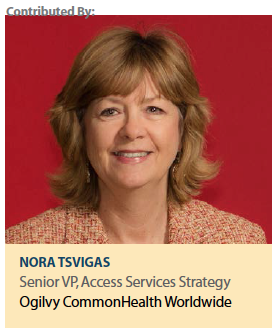 Access services aim to solve almost everything that interferes with the progression from writing prescriptions to the patients receiving their medications. Traditional emphasis has been on reimbursement barriers, solving for coverage issues as well as affordability issues. Many also include patient education and adherence programs, to help patients stay on therapy. These services will remain at the core of patient support; in fact, they are even more important with the evolution of consumer-driven and high-deductible health plan options. The opportunity for improvement lies with the process that bridges the prescription from doctor’s Rx pad to delivery of medicine to the patient.
Access services aim to solve almost everything that interferes with the progression from writing prescriptions to the patients receiving their medications. Traditional emphasis has been on reimbursement barriers, solving for coverage issues as well as affordability issues. Many also include patient education and adherence programs, to help patients stay on therapy. These services will remain at the core of patient support; in fact, they are even more important with the evolution of consumer-driven and high-deductible health plan options. The opportunity for improvement lies with the process that bridges the prescription from doctor’s Rx pad to delivery of medicine to the patient.
What’s staying the same? Health insurance companies and PBMs continue to manage access to pharmaceuticals to ensure profitability. In 2014, 6% of all prescriptions were rejected for coverage by health plans. Of those rejected, 70% required prior authorizations (PAs). More than half of PA prescriptions were abandoned.1
Six percent of all prescriptions may sound small on the surface. However, consider that 75% to 80% of all prescriptions are for generic drugs.
One can quickly realize that this small number (6% of the remaining 25%-30%) represents a full 30% of the entire U.S. branded pharma market, a $425 billion industry. We know that PAs are largely aimed at the higher-cost, specialty products that have dominated new product launches in recent years.
To assess the impact of patient abandonment, one biologic product marketing team measured the number of patients who abandoned product before the access services team completed the PA process. They identified $20MM in abandoned prescriptions among patients enrolled in their program, and completed a benefit investigation.2 These abandoned prescriptions were attributed to the unacceptable length of time between the estimate of benefits (EOB) and PA determination.
The marketing team used this information to garner budget support to make improvements to their access services program. In addition to the clear financial correlation, the team emphasized the negative impact on patients. After all, these patients were identified by a physician as needing the benefits of their drug, but because their disease and symptoms required more immediate attention, they were forced to accept treatment with a potentially less effective alternative. It’s incumbent for manufacturers to find ways to expedite the PA process so that patients can receive physician’s first-choice treatment for their condition.
How can manufacturers improve patient outcomes if their access services programs do not improve access to cutting-edge medicines?
This question must be answered. According to Pharmaceutical Commerce’s 2016 Hub Services Special Report, PAs are increasing at a rate of 20% per year.1 Three new paradigms of the past decade warrant confident investment in access services program changes.
1.“Consumer-driven healthcare" was first coined by Harvard’s Regina Herzlinger over 10 years ago. Because of the lack of pricing transparency in the U.S., consumers have been disempowered to make purchasing decisions. Employers have begun to shift financial responsibility to employees, via premiums as well as via higher coverage deductibles. As a result, many consumers have chosen to forego care (including prescription medicines) rather than pay out of pocket.
Others have begun to seek solutions, mostly leveraging the internet. Google reported last year that one in 20 searches were for health information. At the same time, most U.S. health plans now provide price transparency tools and cost estimators for member use. Independent websites like HealthGrades are growing in popularity and smartphone users have a choice of health management apps.
2.“E-everything" is being used successfully to activate “e-patients," but it’s also an opportunity to drive patient engagement to start and stay on therapy. We already engage patients for copay card/financial support, product and disease education, and adherence support through digital channels. But we traditionally focus on the HCP first for access services overall, especially in terms of enrollment, benefits, investigation and PAs. Some programs even still require HCP enrollment in the program in order for the patient to receive financial support or a copay card. This is a major area of change for access services.
Primarily driven by the CMS HIT mandate, most physicians are now using EHR systems to e-prescribe. By the end of 2018, physicians who do not e-prescribe will become ineligible for government reimbursement: in New York it’s already mandatory. As such, “E-everything" must include HCPs, EHR and e-prescribing, and this presents a tremendous opportunity to engage both prescribers and patients in access services.
For example, for patients with known coverage or affordability challenges, or those in need of additional support from the manufacturer’s programs, enrollment in the program directly within the EHR system at the time of prescription would save significant HCP and staff time normally spent printing, completing, and faxing forms. The EHR can usually auto-populate the entire form, taking provider and patient demographic information from the system along with the prescription information. Because the form cannot be submitted if any essential fields are missed, this eliminates delays and costs that result from follow-up phone calls. Automated EHR enrollment ensures that patients are assessed and assisted as appropriate to their coverage needs.
Copay cards for patients can be automatically submitted with the e-prescription to the pharmacy for adjudication at the time of fulfillment.
Patient education materials can also be printed out for the patient at the time of the visit. And the list goes on from there.
The migration to EHR is here. We need to embrace the technology, and build access services directly into EHR systems for maximum impact.
Automation and efficiency drive cost and time down, while driving patient and HCP satisfaction and activation through the roof. Failure to upgrade our approach achieves the direct opposite.
3. Even the Triple Aim is changing. Another emerging driver that supports an investment in improved access services is the recent push for a fourth component of the IHI’s Triple Aim — one that focuses on the provider. Healthcare bloggers David Chase and Leonard Kish wrote: The “forgotten aim" is a better experience for the health professional. Layering more bureaucracy on top of an already overburdened clinical team ignores that the underlying processes are frequently underperforming, and that a bad professional experience negatively impacts patient outcomes.3
This is a rather broad statement, but it reflects the outdated approach for access services — printing out and faxing forms, managing phone calls, and following up with patients, all to complete what could be a weeks-old prescription. These valuable access services programs actually highlight the significant burden that falls on HCPs and their office staff.
Does it really have to be that way? If we could change that paradigm, would we improve HCP as well as patient engagement? And would that have a positive impact on patient outcomes? I believe the answer is yes, and I believe the opportunity to do so is now.
An Evolving Reality
Manufacturers need to provide ubiquitous availability of information and support, in real time, to patients and providers. That means that all offerings are available across all delivery channels, including:
Phone: a traditional toll-free number, with click to schedule a call capabilities (within the webpage)
Web: websites with personalized downloadable content, mobile responsive design, click-to-chat capabilities, and links to related information
Portal (provider, patient, SP, health plan): online access to coverage reports, copay card balances, shipment tracking, EOBs, status updates, CRM enrollment, opportunity to submit an inquiry, schedule a call, etc
EHR: e-enrollment, e-BV, e-PA, e-copay support, e-trial voucher, e-clinical trial enrollment, downloadable patient information, video content, connectivity to HCP portal for real-time status updates
Connectivity: all channels are linked by a central data hub with two-way exchange of real-time data accessible to all appropriate parties on demand
This access will allow visibility and transparency so patients can engage in the drug acquisition process to their level of ability and willingness, empowering them to self-advocate. This is a bigger idea that will take time to evolve, but it will be the end result of the current intertwined evolution of e-everything and consumerism in healthcare.
Moving in a New Direction
Since the EHR world is rooted in digital exchange of information and data, the following framework provides a great place to start.
Identify the future state for the program is the ideal place to begin
Reimagine the customer experience based on their expectations
Prioritize the steps needed to move toward the future vision
Conduct competitive gap analysis
Select a platform
Selecting a platform is a great divergence from the current status quo, where clients select a “hub" vendor to manage all programs. We urge clients to review and compare emerging vendors based on technological advancement, specialization, expertise, and price transparency. If your research leads you back to your current hub vendor, great. After that, we strongly urge clients to focus on using the “hub" concept with data.
Data aggregation and dissemination in real time will be critical to the future success of access services.
Healthcare’s Digital Transformation Framework4
The bottom line is that very little is staying the same in healthcare. The two largest paradigm changes — consumer-driven healthcare and “E-Everything" — point pharmaceutical manufacturers in a very clear direction to engage with patients. Teach them more about their diseases, their treatments, and how to use them. Teach them the value of continuing to take their medicine as prescribed. Provide them with tools to help them better activate new health behaviors. Finally, contribute to their empowerment so they may advocate for themselves when they need care, and when they run into barriers with their health plan.
In the end, it’s vital to deliver support to both HCPs and Patients through every possible channel in which they may wish to engage — phone, web, digital, portal, online, offline, in person, click to chat and so on. Make certain it’s easy to find, easy to navigate and be mindful of how important it is to be responsive in real time. (PV)
Editor’s Notes: 1. Pharmaceutical Commerce, March 15, 2016, Hub Services Special Report 2016 by Nicholas Basta, accessed 4/13/2016. 2. Data on file at Ogilvy CommonHealth. 3. Healthcare Leadership Blog, 7/18/2015, Quadruple Aim: Care of the Provider. Accessed 7/25/16. https://hcldr.wordpress.com/2015/07/18/quadruple-aim/ accessed 7/25/16. 4. Cognizanti, Volume 8, Issue 1 2015, Part II, Digital Business 2020: “Getting there from Here! Healthcare Rx, the Rise of the Empowered Consumer" Accessed 7/11/16.
Ogilvy CommonHealth Worldwide — the health behavior specialists of Ogilvy & Mather — is committed to creativity and effectiveness in healthcare communications, everywhere.
For more information, visit ogilvychww.com.



















